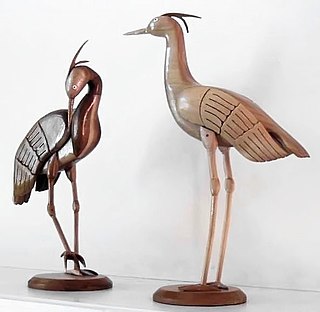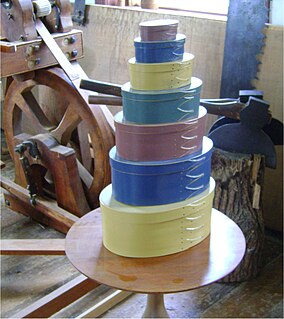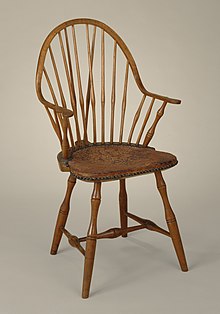
Hugo Alvar Henrik Aalto was a Finnish architect and designer. His work includes architecture, furniture, textiles and glassware, as well as sculptures and paintings. He never regarded himself as an artist, seeing painting and sculpture as "branches of the tree whose trunk is architecture." Aalto's early career ran in parallel with the rapid economic growth and industrialization of Finland during the first half of the 20th century. Many of his clients were industrialists, among them the Ahlström-Gullichsen family. The span of his career, from the 1920s to the 1970s, is reflected in the styles of his work, ranging from Nordic Classicism of the early work, to a rational International Style Modernism during the 1930s to a more organic modernist style from the 1940s onwards.

Woodworking is the skill of making items from wood, and includes cabinet making, wood carving, joinery, carpentry, and woodturning.

A rocking chair or rocker is a type of chair with two curved bands attached to the bottom of the legs, connecting the legs on each side to each other. The rockers contact the floor at only two points, giving the occupant the ability to rock back and forth by shifting their weight or pushing lightly with their feet. Rocking chairs are most commonly made of wood. Some rocking chairs can fold.

Gebrüder Thonet or the Thonet Brothers was a European furniture manufacturer. It continues as a German company, Austrian and Czech (TON).

The No. 14 chair is the most famous chair made by the Thonet chair company. Also known as the 'bistro chair', it was designed by Michael Thonet and introduced in 1859, becoming the world's first mass-produced item of furniture. It is made using bent wood (steam-bending), and the design required years to perfect. With its affordable price and simple design, it became one of the best-selling chairs ever made. Some 50 million No. 14s were sold between 1859 and 1930, and millions more have been sold since.

Bentwood objects are those made by wetting wood, then bending it and letting it harden into curved shapes and patterns.

Artek is a Finnish furniture company. It was founded in December 1935 by architect Alvar Aalto and his wife Aino Aalto, visual arts promoter Maire Gullichsen and art historian Nils-Gustav Hahl. The founders chose a non-Finnish name: the neologism Artek was meant to manifest the desire to combine art and technology. This echoed a main idea of the International Style movement, especially the Bauhaus, to emphasize the technical expertise in production and quality of materials, instead of historical-based, eclectic or frivolous ornamentation.
This glossary of woodworking lists a number of specialized terms and concepts used in woodworking, carpentry, and related disciplines.

Michael Thonet was a German-Austrian cabinet maker, known for the invention of bentwood furniture.

In woodworking, a knee is a natural or cut, curved piece of wood. Knees, sometimes called ships knees, are a common form of bracing in boat building and occasionally in timber framing. A knee rafter in carpentry is a bent rafter used to gain head room in an attic.

Heat bending is the procedure of bending wood into different curves and shapes using moisture and a bending iron. By placing the wood into water, the moisture and heat from the bending iron will reform the structure of the wood, reorganizing the fibers of the wood to prevent the wood from springing back to its original state. This process is usually used for woodworking, as well as making the sides or "ribs" for stringed musical instruments.

Andrew Gronholdt was a famous Aleut from Sand Point, Alaska, in the Shumagin Islands south of the lower Alaska Peninsula and became famous for rejuvenating the ancient Unangan art of carving hunting hats called chagudax. In January 2012, a book was published posthumously by Gronholdt titled "Chagudax: A Small Window into the Life of An Aleut Bentwood Hat Carver" Gronholdt's woodworking techniques, wood steaming and bending methods, and instructional design methodologies were legendary.

A steam box is a long, sealed container used to steam wooden planks for the purpose of making them pliable. Once steamed and then fastened or clamped into the desired position and left to dry, the wood will hold the new shape. Steam boxes allow for much more efficient use of wood. Instead of cutting the desired shape away from a large and more expensive piece of wood and leaving much scrap to be discarded, steam boxes allow for a smaller piece to be bent in the general shape and leaving much less scrap. Steam boxes also allow the wood to bend beyond its dry breaking point, which is useful in making extreme curves with the wood. In many cases, the bent piece is stronger than an identical piece cut from larger stock. Steam bending wood allows the wood grain to follow the bend, leaving it strong where a piece cut from larger stock would snap across crosscut grains or laminated joints.

A stool is a raised seat commonly supported by three or four legs, but with neither armrests nor back a backrest, and typically built to accommodate one occupant. As some of the earliest forms of seat, stools are sometimes called backless chairs despite how some modern stools have backrests. Folding stools can be collapsed into a flat, compact form typically by rotating the seat in parallel with fold-up legs.

Huonekalutehdas Korhonen Oy, formerly called O.Y. Huonekalu- ja Rakennustyötehdas A.B is a former furniture producer located in Littoinen, Kaarina, Finland. The company was once known for manufacturing Alvar Aalto designed furniture.

The Shaker-style pantry box is a round bentwood box made by hand. Such boxes are "associated with Shaker folklife because they express the utility and uniformity valued in Shaker culture."

Molded plywood is the term for two- or three-dimensionally shaped products from multiple veneer layers that are glued together through heat and pressure in a pressing tool. The veneer layers are arranged crosswise at an angle of 90 degrees. Molded wood is used for flat furniture components such as seats, backrests and seat shells. When the veneer layers are arranged in the same direction, it is called laminated wood. It is used for armrests and chair frames. After pressing, the blanks are processed mechanically. A particular feature is the ability to produce different variations of shapes from the blanks. Due to its immense strength and low weight, molded wood is particularly suitable for interior decoration, seating furniture, bed slats, skateboards and vehicle construction.

Gerald Summers (1899–1967) was a British mid-century modern furniture designer. He came to prominence with his design for the Bent Plywood Armchair. Another of his noted works was the Two-Tier Table. Both pieces were designed in 1934 and manufactured by Makers of Simple Furniture, the firm he founded.

Unangan hunting headgear are wooden hats associated with the Unangan, the Indigenous peoples of what are currently known as the Aleutian Islands.

The Model 60 stacking stool is a wooden stool designed by Finnish designer Alvar Aalto in 1933. Manufactured by Artek, the stool is one of Aalto's most famous furniture designs.


























